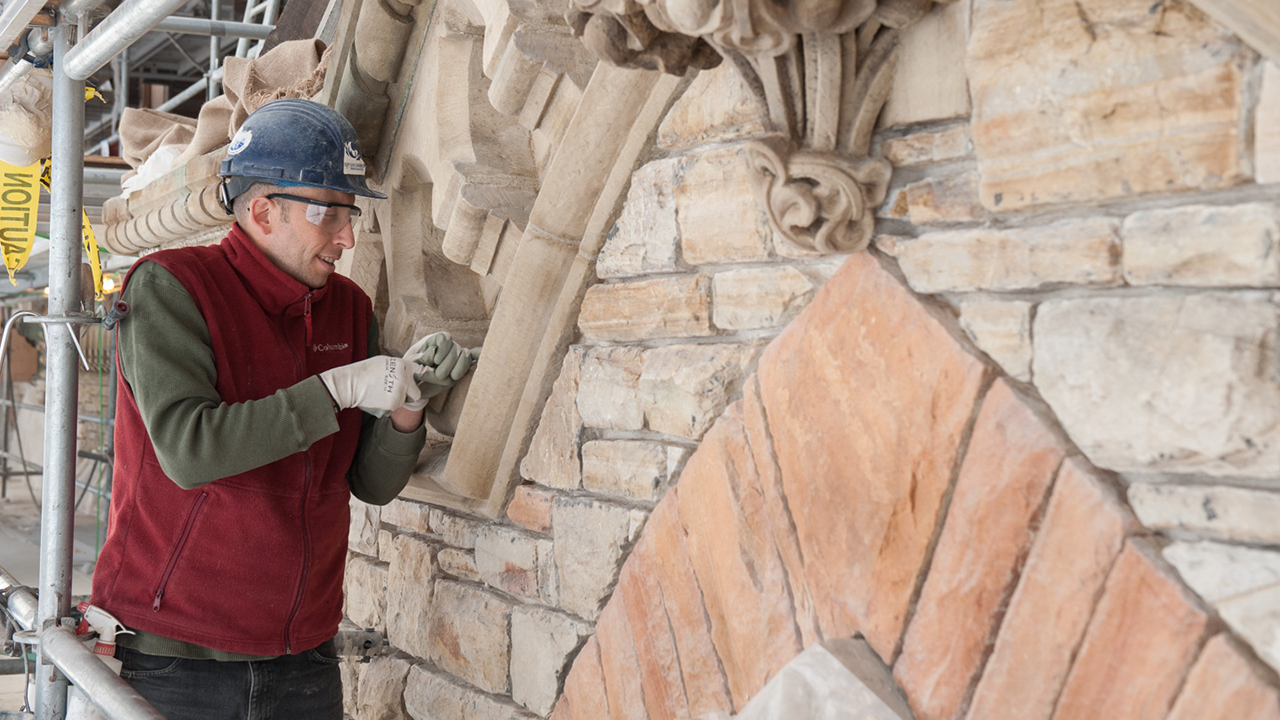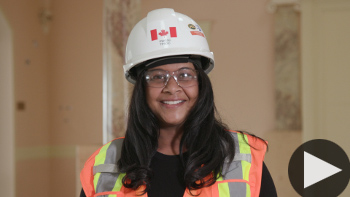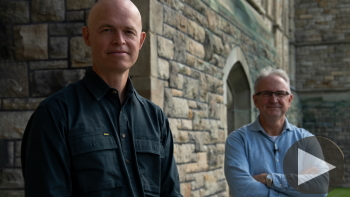How we are restoring and modernizing the Parliament buildings
Learn about how we restore and renew the buildings in Canada’s Parliamentary Precinct.
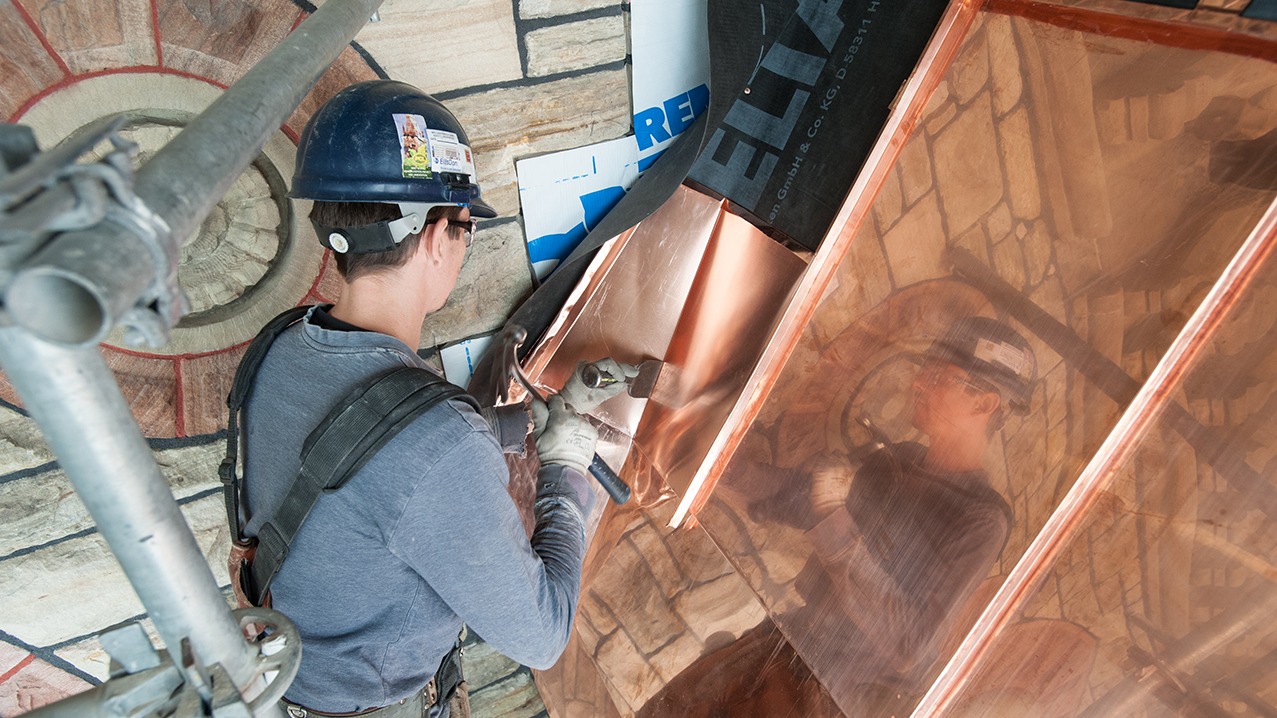
On this page
Restoring and preserving historical buildings
Our projects in the Parliamentary Precinct go beyond simple renovations. To respect the heritage nature of the buildings, we work closely with heritage architects, conservators and other specialists. Together, we ensure that the buildings are renewed so they are safe and meet the needs of a 21st-century democracy, while making them greener and more accessible. All of our projects are unique and complex. They involve many details to ensure every project is managed carefully.
While every project in the Parliamentary Precinct is unique, many aspects of them are similar. Below are a few examples of some of the work we do to restore and update these important historical buildings.
Earthquake-proofing
Ottawa is an earthquake hazard area. Our experts regularly assess how well the Parliament buildings are able to withstand earthquakes. To date, all assessments confirm that the buildings are safe to occupy.
Simplified seismic hazard map for Canada, the provinces and territories
Although safe, most of the buildings on and around Parliament Hill were built before seismic (earthquake-resistance) building codes existed and do not meet current codes. If a building is not up to the standards in the National Building Code of Canada, upgrades are done when the building is slated for major renovation. Various methods are used to make the buildings more resistant to earthquakes.
Studying strength
Before work began, studies were undertaken to better understand how the Parliament buildings would respond to earthquakes. We also analyzed different ways to make the buildings stronger. This analysis informs engineers, stonemasons and other professionals working to conserve these important heritage buildings. With this information and the experience gained from past projects, experts can better preserve the buildings in the precinct and ensure they will last for years to come.
Building on strong foundations
We use various methods to make the buildings more resistant to earthquakes. The traditional approach has been reinforcement. This involves strengthening walls, floors and foundations by shoring up masonry and buttressing it with steel bracing.
Recently, we also started using the base isolation method. This method, widely used in the Asia-Pacific region, uses a sophisticated, multi-layered suspension system. The suspension system absorbs and minimizes seismic energy. During an earthquake, the building remains relatively motionless. We are installing base isolation under the Centre Block as part of the Centre Block project.
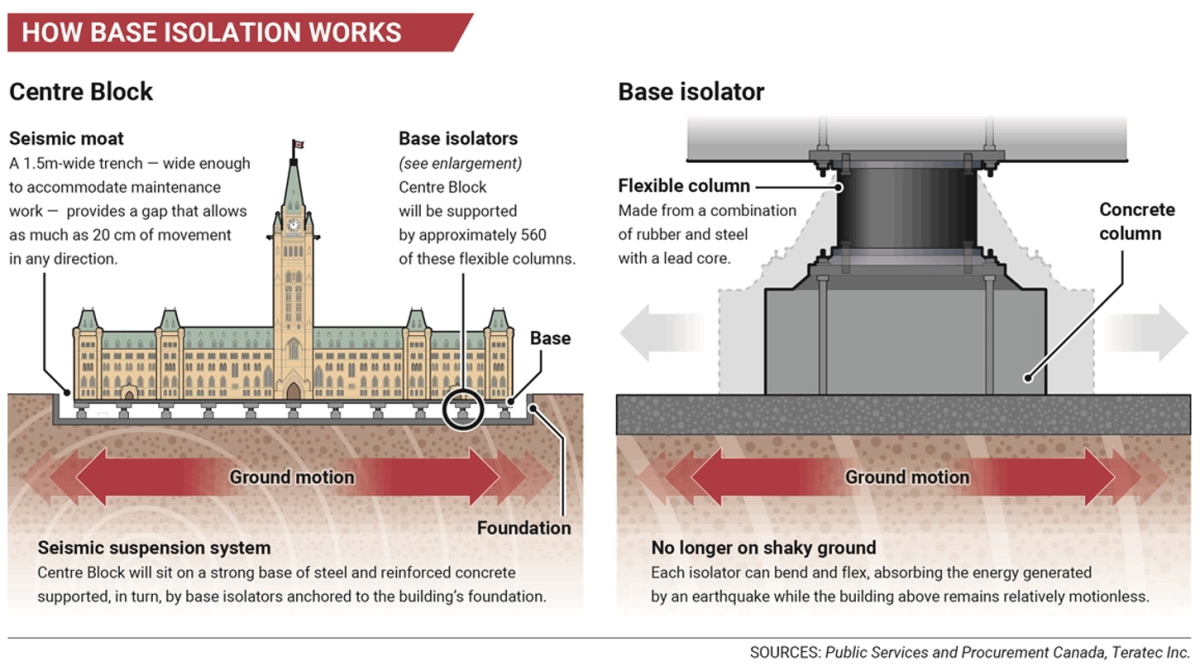
(Select the image to enlarge).
Long description for how base insolation works
How base isolation works
One image divided into 2 parts.
Part 1: Centre Block
A diagram of the Centre Block and the structures and ground below it.
Below the building there is a trench labelled “seismic moat”.
Seismic moat
- A 1.5 m-wide trench
- Wide enough to accommodate maintenance work
- Provides a gap that allows as much as 20 cm of movement in any direction
The base of the building is supported by things labelled “base isolators”
Base isolators
Centre Block will be supported by approximately 560 of these columns.
The foundation is below the moat.
In the area representing underground below the foundations, an arrow pointing in 2 directions horizontally represents ground motion.
Below that it reads:
Seismic suspension system
The Centre Block will sit on a strong base of steel and reinforced concrete supported, in turn, by base isolators anchored to the building’s foundation.
Part 2: Base isolator
A zoomed-in illustration of a base isolator.
Below the base of the building is a cylinder labelled “flexible column”.
Flexible column
Made from a combination of rubber and steel with a lead core.
The flexible column sits on a concrete column.
In the area representing underground below the foundations, an arrow pointing in 2 directions horizontally represents ground motion.
No longer on shaky ground
Each isolator can bend and flex, absorbing the energy generated by an earthquake while the building above remains relatively motionless.
Reinforcing masonry walls
When they first begin their analysis, stonemasons examine a wall and note which areas of the wall need to be repaired or stabilized. They then take apart those sections of the wall stone by stone, taking note of where each stone came from. This allows them to see the wall’s condition and adjust the scope of work if needed.
The next step is to rebuild the wall with new mortar. The masons return the stones to their original position when possible, or replace stones that are too damaged to be used again. When they rebuild the wall with new mortar, they install steel anchors to connect the masonry together. This makes the walls stronger and more resistant to earthquakes.
Laser cleaning
Over the years, different types of cleaning methods have been used on Parliament Hill.
Laser technology offers a 21st-century solution for a medieval craft. Using a highly focused, powerful light source, stonemasons simply vaporize dirt from the stones. The lasers can clean the stones without touching them. This is far more convenient than the traditional cleaning method, which involved scrubbing with water and chemicals. Traditional methods are still relevant and used in certain areas where it’s difficult to clean with a laser.
Lasers are now a standard tool in the stonemason’s kit, right beside the traditional trowel.
Watch the video below to see laser cleaning in action.
Video: Laser cleaning the Parliament buildings
Heritage conservation
Many of the buildings on and around Parliament Hill are designated Federal Heritage Buildings. While we restore and modernize important historic buildings, we aim to maintain their heritage value and character. We work with experts who specialize in conserving heritage buildings to help us safeguard or restore architectural features such as stone carvings, metalwork, woodwork and tiles.
Video: Protecting the Centre Block's valuable heritage assets
Canada's Dominion Sculptor
Canada's Dominion Sculptor is responsible for carving and conserving statues, portraits and decorative pieces to commemorate Canada's history, people, events and character in Parliament Hill's Centre Block and other government buildings in the Parliamentary Precinct.
Canada has only had 6 Dominion sculptors since the position was established in 1936. The role was created to fulfill the vision of the architect of the Centre Block, John Pearson. In his design, Pearson included some 3,000 blank stone blocks on the outside of the Centre Block and about 2,500 more on the inside.
The stones were left empty so that future generations of sculptors could carve the ongoing story of Canada's history and culture for decades and even centuries to come. About 180 blank blocks remain to be carved.
As time takes its toll on the buildings, the Dominion Sculptor is required to put more energy into conservation and restoration. He sculpts statues, portraits and decorative pieces, and continues to carve our history into the stones of the Centre Block.


